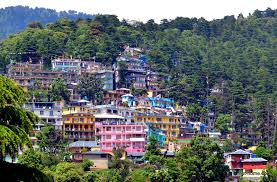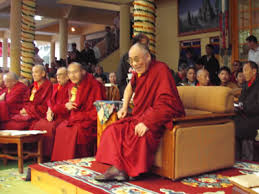|
Dharamsala is perched on the high
slopes in the upper reaches of Kangra Valley. The town is divided
into two distinct and widely separated sections, Upper and Lower
Dharamsala, which differ almost a thousand metres in height. Kangra Valley. The town is divided
into two distinct and widely separated sections, Upper and Lower
Dharamsala, which differ almost a thousand metres in height.
Dharamsala over looks the plains and is surrounded by dense pine
trees and Deodar forests. A nearby snowline with numerous streams
and cool healthy atmosphere makes the surroundings very
attractive.
Dharamsala is a busy bazaar town and has established itself as the
travellers base camp, who come to explore the nearby mountains.
The Kotwali Bazaar provides the entire colour and characteristic
of a small town, which is mixed with the simple life style.
The colourful temple and Gompas, which reflect the culture of
Tibet, adds attraction for the visitor. The Kangra museum gives an
overview of the rich past of the region and on the other hand
there are institutes that have been established to preserve the
Tibetan art, cultures and traditions.
Dharamsala, popularly known as
 the
"Queen of the Hills", is divided into lower and upper towns
with a difference of 457m(1500ft.) between them. The mountains
enfold 3 sides of the town and the valley stretches to the south.
There is a beautiful resort of Dharamsala, which stands on the
spur of the Dharamsala range Dharamsala is known for its scenic
beauty, calmness and serenity. It has high pine trees, tea gardens
and timber yielding trees. the
"Queen of the Hills", is divided into lower and upper towns
with a difference of 457m(1500ft.) between them. The mountains
enfold 3 sides of the town and the valley stretches to the south.
There is a beautiful resort of Dharamsala, which stands on the
spur of the Dharamsala range Dharamsala is known for its scenic
beauty, calmness and serenity. It has high pine trees, tea gardens
and timber yielding trees.
Dharamsala is now the seat of His Holiness, the Dalai Lama.
After the Chinese conquest of his country, Dharamsala is evocative
of the imperial days in places like Mcleod Ganj and Forsythe Ganj.
Dharamsala is the headquarters of the Kangra district. It became
the capital in 1852 and is 125 years old.
An earthquake once wrecked Dharamsala in 1905. Since 1960, it
became temporary headquarters of the Dalai Lama and has risen to
international repute as " The little Lhasa in India". After the
Indo-Chinese and Indo-Pak wars, the govt. erected war memorials of
jawans and officers belonging to Kangra, who died in the war.
Tibetan environment has been created in the high altitude, and
more than 3000 Tibetans have made Dharamsala their temporary home,
living mostly in Mcleod Ganj. To add to its beauty, there is an
artificial stream flowing, gleaming with gold fish.
Tibetans took shelter in India in 1959. In the wake of Dalai Lama’s
flight from Tibet, 85000 Tibetans were devastated. Their spiritual
leader dalai lama given up the hope of a free Tibet, but to keep
the Tibetan art alive, efforts have been made to preserve them.
Tibet’s unique form of Thongka painting, woodcarving, metal
–crafts and music are very famous. Tibetan works and archive are
preserved in the library at Dharamsala where Buddhist monks from
distant refugee camps come to study ancient manuscripts
Mcleod Ganj
Tibet has lent importanc e
to Mcleod Ganj. The Buddha temple is situated opposite the present
abode of His Holiness, the Dalai Lama. This place is well worth a
visit and around it is situated Tibetan monasteries and nunnery. A
number of residential buildings, restaurants, antique and curio
shops are present. There is an annual 10-day fair opera in
Dharamsala, which takes place on the second saturday of April. e
to Mcleod Ganj. The Buddha temple is situated opposite the present
abode of His Holiness, the Dalai Lama. This place is well worth a
visit and around it is situated Tibetan monasteries and nunnery. A
number of residential buildings, restaurants, antique and curio
shops are present. There is an annual 10-day fair opera in
Dharamsala, which takes place on the second saturday of April.
War Memorial:
It is a very beautiful place to visit in the afternoon. This
memorial is built near the entry point to Dharamsala. It was built
to commemorate the memory of those who fought in defense of the
motherland. People offer prayers at this memorial place.
Triund:
It is 17km from Dharamsala and lies at the foot of the snow clad
Dhauladhar at a height of 2827 m. It is a popular picnic and
trekking spot.
Kunnal Pathri:
Just 3-km level walk from Kotwali Bazaar, is a rock temple of the
local goddess at Kunnal Pathri spots
Lord Eligin's Memorial:
It is a world famous church built in the memory of lord Elgin, the
Scottish working peer and eighth Viceroy. In 1896, he took
vacations from official Shimla. He was not able to finish his
four-year term and died in Dharamsala. Before his death he had
given instructions to be buried in the Church of St. John. Inside
the church is the monument of this Viceroy.
Dal lake:
The picturesque Dal Lake is about 11km from Dharamsala. It is
surrounded by fir trees. There is an annual fair in Sept. and is
largely attended by Gaddis and other hillmen.
The Shrine of Bhagasunath:
The shrine of Bhagasunath is famous for its ancient temple. It is
11km from lower town. Slate quarries are found here. There is a
tank and spring which are considered sacred by the Hindus.
Chamunda Devi : Chamunda De vi
is the famous temple dedicated to the Goddess Chamunda Devi. It is
situated in the village of Dadh, 15 km from Dharamsala. One can
have a glorious view of Dhauladhar on 3 sides and the Baner Khud,
Pathiar and Lahla forest. vi
is the famous temple dedicated to the Goddess Chamunda Devi. It is
situated in the village of Dadh, 15 km from Dharamsala. One can
have a glorious view of Dhauladhar on 3 sides and the Baner Khud,
Pathiar and Lahla forest.
Trilokpur:
It is 41km from Dharamsala, easily approachable by road. It is
well known for its natural cave temple, which contains stalactite
and stalagmite (hanging from the roof of the cave). This temple is
dedicated to Lord Shiva. Ruins of palaces and Baradari of Lehna
Singh Majitha, Governor of Kangra hills, are present high on the
ridge of the cave.
|